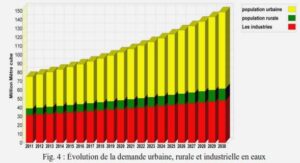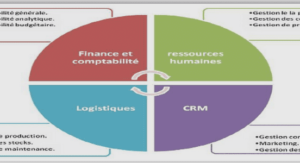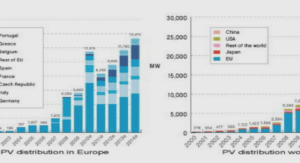Les déterminants socio-économiques et culturels de la jeunesse
Religious institutions and the socialization of young people
Religion is an important socialization mechanism as it plays a key role in the transmission of values and behavior. According to Berns (2012: 193), traditions, rituals and religious 29 institutions are responsible for the reinforcement of the values which are taught in families. Furthermore, religious orientation influences the families’ socialization practices by providing an ideology that enables individuals to comprehend events that happen to them. Among the youth, religious participation improves psychological wellbeing (Wright et al., 1993) and has also been found to be inversely related to delinquency and other high risk behaviours (Donahue et al., 1995). Powell (1963) observes that religion provides persistent values, improving daily living and establishing a clearer outlook of life. Furthermore, an individual’s religious and social context influences his attitudes and behaviors. Rossenberg’s (1965) study among young people in the USA found out that when an individual is isolated from his religious group, he was found to display certain psychic consequences, majorly of emotional nature and eventually experienced a low self-esteem. Other studies have noted a positive relationship between religiosity and a sense of moral worthy and ability to control personal affairs (Furseth, et.al, 2006; Engebretson, 2004; Ploutzian et al., 2005). When the individual is isolated from his religious group, one tends to face his immediate environment without the sustenance of group support. Organizations and communities are also said to promote favourable self-images among young people by providing opportunities for positive reflected appraisals (Regnerus, 2003). In their study to examine the role of religion on Mother –child relationship, Pearce et al., (1998) found out that the more important religion is to the mother, the more likely her child was to report a higher quality of relationship with her. However, other studies have found out that the parental public religiosity curbs the frequency of conversation with regard to sexual socialization of adolescents (Regnerus, 2005). As such it was found out that while such parents claim to be talking to their adolescent children about sex and birth control, the study shows that what parents are exactly communicating is less clear and that they only appear most likely to be conveying sexual values. Worse still, such devoutly religious parents appear much less apt to talk to their children about sex and birth control as well as more likely to report difficulty in communicating. Religious involvement among young people has also been found play an important role in shaping attitudes towards sexual activities, with studies showing delayed transition into sexual activity and its multiple outcomes such as teenage pregnancy and sexually transmitted infections. In a study to determine the association between religious involvement and 30 adolescent sexual activity, Burdette and Hill (2009) found out that the said association varies according to measure of religious involvement and the form of sexual activity under investigation. Of these, religious salience was found to have a particularly strong association with delayed adolescent sexual behavior as compared to private religiosity, church attendance and family religious behaviors and religious affiliation. Burdette et. al (2009) attribute this to the fact that religious salience is the only one aspect of religious involvement that adolescents are able to control through their perceptions of religion’s influence in their daily lives, while some adolescents may not be able to control the regularity of their church attendance and the religious behavior of their families. Other social institutions play a supporting role in the religious socialization of adolescents in society. For instance, the family, peers and the schools jointly offer the young people a meaningful system with which to interpret religious experience and model relevant religious behavior (Spickard, 1988). However, parents retain a strong influence on their adolescent’s religiosity, even after accounting for the adolescent’s schooling situation, friends’ religiosity and extra familial mentors (Uecker, 2008). In a study to test the impact of parental religious influence on adolescent religiosity among 235 American families, Kiren and Munroe (1987) discovered that paternal and marital variables were significantly associated with the religious activities of both the male and female adolescents. On the other hand, however, only paternal religious activity variables were significantly associated to female adolescent religious activity. In the traditional religious setting, the “rites of passage” comprised one of the many personal rituals that surrounded the principal events in the lives of individuals and was considered a great transition from childhood into adulthood to make him a full person and introduce him or her to sex life. However, modern life has resulted in the “thinning” of the custom to a hurried performance (Parrinder, 1981; Magesa, 2008). In the contemporary society, religious influence has been found to have a dual impact on the socialization of young people. As supported by the findings of the study (see section 6.3.2), while religion has the potential to promote resilience and provide mechanisms for coping among young people, some of the religious doctrines and the precarious nature of the youth render them liable to be influenced negatively. Thus, while religion may accrue great benefits 31 to young people, other instances may breed negative consequences leading to undesirable outcomes among the youth.
Social change and the socialization of young people
According to Mayers (1974), change entails alteration brought about by interplay among the forces and movement of tradition, drift, tension, adaptation as well as innovations. On the other hand, Vago (1999:9) conceptualizes social change as “a process of planned or unplanned qualitative or quantitative alterations in social phenomena that can be analyzed in terms of five interrelated dimensions of identity, level, duration, magnitude and rate”. Social change is characterized by a relatively stable system of social stratification, based largely on role ascription and the traditional criteria for the assignment of prestige, replaced by extensive social mobility with status largely assigned on the basis of achievement, in turn intimately linked with the attainment of educational and technical skills ( Cheung et .al, 2010). In the realm of values and fundamental life ways, religion tends to lose ground to the progressive secularization of values and distinctive national folk cultures, with their infusion of religious prescription, significantly giving way to a more uniform national culture with the pre dominance of rational – legal norms for regulating individual behavior (Montoro, 1993). The transformations experienced by society in recent decades demonstrate that the social changes accompanying the process are indeed abrupt and massive (Baum, 2002). The result has been the emergence of a condition of “deregulation in society”, the situation that Emile Durkheim variously referred to as “social anomie” entailing the “breakdown of rules on how people in society ought to treat one another” and hence people do not know what to expect from others. Ritzer, (2007: 112) has observed that when this situation obtains: There are few, if any, clear strong collective ideas about things. As a result confronted with many issues …… people simply do not know what they are supposed to do. More generally, people are a drift in society and lack clear and secure moorings……..this contrasts strongly with mechanical solidarity in which everyone is very clear about what the collectivity believes and what they are supposed to do in a given situation. Societies with high levels of anomie create problems of socialization of its members (Katsas, 2012). Pointing out that though socialization will be problematic does not mean that members 32 of the society will not socialize; Katsas observes that instead, it will contain the building blocks of a social structure characterized by anomic situations. According to Akonga (1997 18), in the event of “rapid socio- cultural, technological and ecological change, a disjunction developed between the previously integrated elements that held the society together”. As pointed out above, partly due to the ineffective application of the prevailing society’s norms and the inability of the members of the society to deploy the newly introduced ones, “the society becomes overwhelmed by the change, leading to “social death”. Due to lack of any authority to provide moral guidance to its members on the correct goals and the means to attain them, those who stick to the old norms are regarded as old fashioned while others come up with modern alternative–numerous “individualistic” and “personally constituted mechanisms of goal attainment”. The implication is that no equivalent replacement of institutions is created. As Katsas, notes, this effectively leads to the loss of a firm reference point. Hence, as society experiences change, the socializing agents experience greater challenges as there are more choices to be made. A key concern to this study is how the period of adolescence and youth can be adjusted to accommodate all the opportunities that are available. As demonstrated by the findings of this study, the adult socializers in South Western Kenya have been affected directly by the uncertainty that rapid change has produced as well as the opportunities and challenges that these present. For instance, whereas the adoption of new media and technological innovations by the young people for communication and learning presents positive opportunities (see section 6.4.1), it is paradoxical that the development is perceived as being detrimental to the wellbeing of the youth and community. The impact of social change has been a key area of concern in sociological analysis, with the founding fathers profoundly concerned about the disruptive effects of change in society. Whereas Emile Durkheim regarded the changes brought about by the industrialization as a threat to the prevailing social order through the breakdown of normative consensus leading to anomie, Marx saw the dehumanization of man (alienation) brought about by the capitalist mode of production, making man a commodity and work becoming a degrading necessity as issues of concern (Zhao et.al, 2010; Clarke, 1991; Zdraromyshov, 1998. On the other hand, Max Weber and Ferdinand Tonnies viewed change as a threat to the close effective relationships of the traditional society (Giddens, 1994). 33 Marx further argues that the changes in the material production creates pressure for wider social changes and that at any level of technological development , there will be a “corresponding set of social relationships and accompanied by a degree of social disruption” (Hughes et.al, 2003) . Eisenstadt (1966) further observes that the continued change involves processes of disorganization and dislocation giving rise to continual development of social problems and conflicts between various groups and resistance to change. Kempny (1996) has shown that the claim by anthropologists and sociologists that tradition stands in opposition to change and that change always brings about disorganization is untrue. On the contrary, he avers that it can in fact generate processes that positively transform cultural reality. He adds that change from the point of view of an individual means to either legitimize what is novel in social life or resist the new patterns through creativity and invention. The latter is mainly achievable through adaptation, diffusion and innovation (Hamblin, et. al, 1973). However, according to Illich (1971), there are three factors which constrain invention, creativity and action, and these constraints become a responsibility of those who experience them as “shackles”. Thus, social change involves a triple action: Reorganization of the social structure, often regarded as subversion or revolution, attempting to get behind public illusions which justify structures and the emergence of a new “social character” which is experienced by many with utter confusion and character. All in all, in order to escape out of the destructive impacts of social change, Cotgrove ( 1978) says that man is well endowed with skills and the requisite tools necessary to craft , negotiate and bargain in both structured and unstructured situations as it is possible for him to decide “who” he is (Identity). The above views are justifiable as indeed, societal change produces tension as demonstrated in the parent–child knowledge divide in the study area. Also, the changing trends among parents’ goals for child rearing and schooling are visible. Interestingly, there exists a huge difference in viewpoints among parents and their young off springs with regard to the above. This is mainly attributed to the differences in their motivation and focus for living and life goals. However, the disparities can be tackled by reducing the gap. Therefore, schools and 34 other institutions should endeavor to involve and make parents active partners in their programmes for the young people since adolescent and youth socialization is a collective activity.
Adolescent socialization as a collective process
Unlike the other rites of passage, those performed to usher in the young people’s transition into adult life are performed collectively. Wagner (1970) observes that among the Bukusu and Maragoli communities of Western Kenya, the aforementioned was rationalized on account that the significance of the process “extended beyond the orbit of the individual’s life cycle”. Wagner (1966:335) says: These events furnish the occasion for observances that affect much wider groups and serve much wider functions than those bearing on directly and immediately upon the individual concerned. Shorter (1994) adds that among the indigenous African societies, the Child’s education was meant to accord her membership to the community. As in all societies, such rites he says were a clear manifestation of the interest of the whole community in the upbringing of the child. Later on, the education could be grouped oriented. Children brought up in this manner developed greater self-assurance and established a wider network of personal links and are bound to enjoy greater success in life. The above aspect of community implies shared beliefs and customs and commitment by all its members. Hence, when younger members of the society discern the impression that everyone is involved, they perceive the available support and adult role model as real. As a consequence, this motivates them to reciprocate by abiding by the society’s norms and values. The lack of collective initiatives weakens the intangible community support system. According to George Herbert Mead, individual members of the society “become able to understand what is expected of them, and what they are supposed to do in a group (Blumer, 2004). He argues that one’s behavior (“I”) or (“SELF”) – that part of the individual’s personality made up of self-awareness and self-image – reflects the larger social structures that go beyond the “self”. He proposed that a “complete self (effective socialization)” is only possible when a (young person) moves beyond taking the role of individual “significant 35 others” and takes the role of “generalized others” – broad cultural norms and society’s values. Individuals are able to evaluate themselves from the point of view of the group as a whole and as a matter of fact, in order to have a “self”, one must be a member of a community and be directed by the attitudes common to the community (Gould, 2009). The central idea here is that the self” does not exist at birth but is acquired through social experience, majorly comprised of exchange of symbols eventually resulting in what mead refers to as “consciousness of the self (Kashima et.al, 2007). Thus, when an individual reside within a closely knit system of individuals and families, the individual gains access to a repertoire of resources and frame of references who serves as a point of reference. These provide him with a network of readily available and reliable support from which he derives the much needed motivation and local cultural orientation. However, with the disappearance of the less static and coming up of the ambiguous socio – cultural arena, the young people today face problems in establishing a secure sense of personal identity and cultivation of a stable value system (Conger, 1975). Challenging this view, Bauman (2004) argues that in the modern world people are not born into their identities. That they are required to construct identities themselves and hence the collective pool of community norms and resources upon which an individual negotiates are unnecessary. Referring to a “project of the self”, Giddens (1991: 112) observes that in late modernity, a sense of identity is something upon which people work and identity becomes “less a package of received personal characteristics but a matter of defining the meaning of where they have come from, who they are now and where they want to go”. From this perspective, as adult identities no longer naturally follow from childhood, young people can imagine futures different from those implied by received identities. However, these cannot be based entirely on a vacuum; certain kinds of “social capital” and consumption of particular objects are required, such as technology, educational resources and so forth (Bradford, 2012). Further, increasing urbanization and geographic mobility and the weakening of the extended family leading to isolated nuclear families and the emergence of the “youth culture (s)” have further served to intensify the societal polarization and eventual decline of the authority of the traditional social institutions. Consequently the mass media has stepped in to fill the gap, becoming a central part of the cultural environment of society, of course with far reaching implications in the socialization of the youth (Arnett, 1995). 36 Nevertheless, the stepping in of the media as explained above cannot fully replace the face to face interaction that ensues among individuals. As a form of communication in which an individual obtains information through an impersonal medium, it is impossible to adopt the message to the interest and understanding of the receiver. In this study an important question is whether the media can be regulated in order to serve as an effective socialization agent in the study area.
The mass media and socialization of young people
The mass media has increasingly become an important component of the social element among people of all ages in contemporary society (Dubow et al., 2006). In both the developed and the developed regions of the world, it has become a significant source of values (Okafor et. al, 2013) and hence plays an important role as an agent of socialization (Rubin, 1994). The daily use of the media has “permeated the lives of young people’s lives, so much that it is hard to believe that less than a decade ago the technologies barely existed (Horst et al., 2008).” An important question is what such a transformation in the socio – cultural environment portends for the socialization of young people. Arnett (1995) observes that what has transpired is that the youth have taken to using the media for “selfsocialization”. The media material is used towards identity formation, occupational preparation, gender role learning and the development of a set of values and beliefs (Anderson, L et al., 2012). Conversely, the presence and influence of the family has been on the decline (Martin, 1990). Arnnet (1995) further observes that the main challenge for the young people is that as a socializing agent, the media operate in an environment which is uncontrolled and offering a wide array of information and influences for the recipients to choose from. Secondly, whereas the traditional agents of socialization like the family, schools and religious institutions aimed at passing on attitudes and beliefs in order to preserve the social order and transmit the uniform culture from one generation to the next, the mass media are driven by the “profit motive” and as such, the content that is packaged for the young people depends on what presumably is appealing to the young recipients. Consequently, the young people maintain greater say over their socialization. The parents are thus denied the opportunity to supervise and impose any restrictions on what allay of media products are to be accessible to the younger members of the society. 37 Numerous studies have observed that the young people are in essence, endeavoring to come up with “alternative ecologies” for seeking a sense of empowerment that they consider as otherwise lost onto the adult world because of their marginal socio – economic and cultural position in contemporary society (Grbich,1990; Bulcholtz,2002; Heilbronner, 2008; Skelton,1998 ). As such, the mass media are seen to play a liberating function, so that they can increase the young people’s independence in the socialization process. However it can also work towards broadening the incoherence and a lack of integration as observed in the contradictions among the messages produced leading to confusion and alienation (Qin, 2006). From the foregoing discussion, it can be concluded that the media constitute a useful socializing agent in the contemporary society. However, its peculiar feature of influencing values, beliefs, attitudes and behavior makes it a shaper of culture. As pointed out, the orientation so propagated may not at all times be in the best interest of the recipient. Hence, variables such as the age, cognitive ability and adult supervision activities accompanying media use by the young people become of paramount importance. Thus, for the young people, it is not so much what the media does to them but what they do with the media that will bring about positive or negative socialization outcomes. In Kenya, the media, especially the internet, has become a youth–culture. In this study, the adoption and utilization of the mass media for self – socialization is at the core of the investigation
ABSTRACT |





